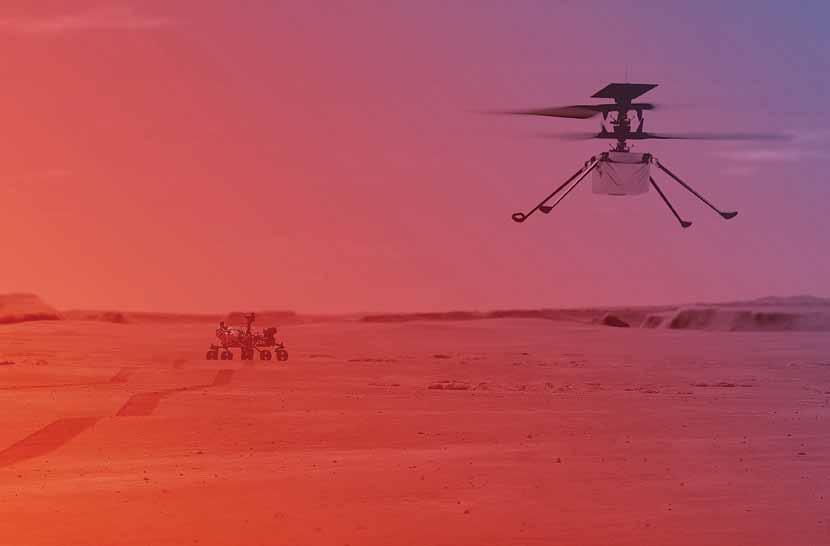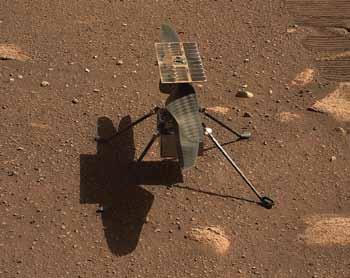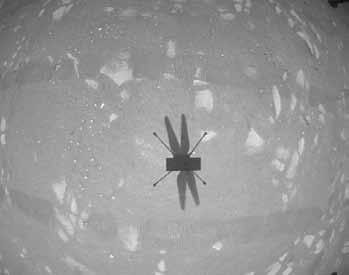
8 minute read
Ingenuity
aN iLLuStratioN of NaSa’SiNgeNuity heLiCoPter fLyiNg oN MarS
IngenuIty: takIng scIence & exploratIon to new heIghts
Having demonstrated the possibility of powered, controlled flight on another planet, NASA’s Ingenuity will now explore flight operations that future aerial craft could utilise
By Ayushee ChAudhAry
NaSa’s Ingenuity team had their Wright Brothers that humanity has never seen before. moment in the most thrilling manner with the Mars Helicopter The feat achieved by this small rotorcraft, hovering above taking its first flight on the red planet Jezero Crater, is historic as it showand further expanding the horizons in cased that powered, controlled flight on its following three flights. On April 30, another planet is possible. the Ingenuity Mars Helicopter took off The small rotorcraft has been for its fourth flight that set records on In the fourth flight expanding it horizons with every flight Mars flying faster and farther than in any tests it went through on Earth. In on April 30, the it has taken. On April 25, the helicopter took off its third flight rising 16 feet the fourth flight, the helicopter climbed helicopter climbed – the same altitude as its second flight an altitude of 16 feet before flying south approximately 436 feet and then back for an 872-foot round trip. The rotoran altitude of 16 feet before flying south and then raced down 164 feet, just over half the length of a football field, reaching a top speed of 6.6 feet per second. craft was in the air for 117 seconds, as approximately 436 Prior to that the second flight was comreported by NASA (National Aeronautics and Space Agency). A lot of images feet and then back for pleted on April 22, lasting 51.9 seconds. That flight had added several new chalhave been captured during the flights, an 872-foot round trip lenges to the first, which took place on providing an aerial perspective of Mars April 19, including a higher maximum
iNgeNuity teSt fLight aCtivitieS(iLLuStratioN)

altitude, longer duration, and sideways movement. While the captured its first images on Flight Two. The helicopter’s blackfirst flight taken by Ingenuity topped out at 10 feet above the and-white navigation camera, meanwhile, tracks surface feasurface, Ingenuity climbed to 16 feet tures below. Apart from focusing on the the second time. After the helicopter algorithm that tracks surface features, the hovered briefly, its flight control sys- team needs the correct image exposures tem performed a slight (5-degree) tilt, allowing some of the thrust from the On April 25, the as well, dust can obscure the images and interfere with camera performance. counter-rotating rotors to accelerate Ingenuity Mars After receiving data from Mars, Ingethe craft sideways for 7 feet during the second flight. Helicopter set nuity’s team at NASA’s Jet Propulsion Laboratory (JPL) in Southern California The video of Ingenuity was cap- records in its third is looking into a pile of information gathtured from by the Mastcam-Z imager aboard NASA’s Perseverance Mars rover, which is serving as a commuflight on Mars as it flew faster and ered during these flights that will inform not just additional Ingenuity flights but possible Mars rotorcraft in the future not nications base station. The Ingenuity farther than in any just unmanned but also those with astroteam has been pushing the helicopter’s limits by adding instructions to cap- tests it went through nauts as NASA is gearing up for the first manned mission to Mars. ture more photos of its own – includ- on Earth “Today’s flight was what we planned ing from the colour camera, which for, and yet it was nothing short of amaz-

(toP) MaStCaM-Z giveSiNgeNuity’S a CLoSe-uP; (BottoM)iN-fLight iMage froMiNgeNuity SeCoNd fLight.


ing. With this flight, we are demonstrating critical capabilities nition of the ingenuity and innovation that continue to propel that will enable the addition of an aerial dimension to future exploration.” Mars missions,” said Dave Lavery, the project’s programme Grip also announced that the International Civil Aviation executive for Ingenuity Mars Helicopter at NASA Headquarters Organisation (ICAO) – the United Nations’ civil aviation agency in Washington. – presented NASA and the Federal Aviation Administration with
“So far, the engineering telemetry we have received and official ICAO designator IGY, call-sign INGENUITY. These details analysed tell us that the flight met expectations and our prior will be included officially in the next edition of ICAO’s publicacomputer modeling has been accurate. We have more flights tion Designators for Aircraft Operating Agencies, Aeronautical of Mars under our belts, which means that there is still a lot Authorities and Services. The location of the flight has also been to learn during this month of Ingenuity,” Bob Balaram, chief given the ceremonial location designation JZRO for Jezero Crater. engineer for the Ingenuity Mars Helicopter at NASA’s JPL said. As one of NASA’s technology demonstration projects, the
Operating an aircraft in a controlled manner at Mars is 19.3-inch-tall (49-centimeter-tall) Ingenuity Mars Helicopfar more difficult than flying one on Earth but it is certainly ter contains no science instruments inside its tissue-box-size worth the challenge. As each second of every flight that Inge- fuselage. Instead, the 4-pound (1.8-kg) rotorcraft is intended to nuity takes on Mars, provides an abundance of Mars in-flight demonstrate whether future exploration of the Red Planet could data for comparison to the modeling, simulations, and tests include an aerial perspective. performed back here on Earth. Not just that, through these This first flight was full of unknowns, NASA remarks. The NASA has also gained its first practical experience operating a Red Planet has a significantly lower gravity – one-third that rotorcraft remotely at Mars. These datasets will further prove of Earth’s – and an extremely thin atmosphere with only 1 invaluable for potential future Mars missions that could enlist per cent the pressure at the surface compared to our planet. next-generation helicopters to This means there are relaadd an aerial dimension to their tively few air molecules with explorations. which Ingenuity’s two 4-foot-
The Ingenuity Mars Helicop- wide (1.2-meter-wide) rotor ter project is a high-risk, high- blades can interact to achieve reward technology demonstra- flight. The helicopter contains tion, as NASA puts it. The agency unique components, as well as further adds that even if Ingenu- off-the-shelf-commercial parts ity were to encounter difficulties – many from the smartphone during its mission, the science- industry – that were tested in gathering of NASA’s Perseverance deep space for the first time Mars rover mission wouldn’t be with this mission. impacted. “We have been thinking
Acting NASA Administrator for so long about having our Steve Jurczyk said, “Ingenuity is Wright Brothers moment on the latest in a long and storied Mars, and here it is,” said MiMi tradition of NASA projects achiev- Aung, project manager of the ing a space exploration goal once Ingenuity Mars Helicopter at thought impossible. The X-15 JPL. “We will take a moment to was a pathfinder for the space iNgeNuity’SfirSt BLaCk-aNd-White iMage froM the air celebrate our success and then shuttle. Mars Pathfinder and its take a cue from Orville and WilSojourner rover did the same for bur regarding what to do next. three generations of Mars rovers. We don’t know exactly where History shows they got back to work – to learn as much as they Ingenuity will lead us, but the results indicate the sky – at least could about their new aircraft – and so will we.” on Mars – may not be the limit.” After successfully proving that powered, controlled flight is
Ingenuity’s initial flight demonstration was autonomous – possible on the Red Planet, the Ingenuity experiment will soon piloted by onboard guidance, navigation, and control systems embark on a new operations demonstration phase, exploring running algorithms developed by the team at JPL. Because data how aerial scouting and other functions could benefit future must be sent to and returned from the Red Planet over hun- exploration of Mars and other worlds. This new phase will dreds of millions of miles using orbiting satellites and NASA’s begin after the helicopter completes one more flight. The deciDeep Space Network, Ingenuity cannot be flown with a joystick, sion to add an operations demonstration comes as a result of and its flight was not observable from Earth in real time. the Perseverance rover being ahead of schedule with the thor-
Following the first flight, NASA Associate Administrator for ough checkout of all vehicle systems since its landing. Science Thomas Zurbuchen announced the name for the Mar- It was February 18 this year that Perseverance touched tian airfield on which the flight took place. “Now, 117 years down Mars with Ingenuity attached to its belly. Deployed to the after the Wright brothers succeeded in making the first flight surface of Jezero Crater on April 3, Ingenuity is currently on on our planet, NASA’s Ingenuity helicopter has succeeded in the 16th sol, or Martian day, of its 30-sol (31-Earth day) flight performing this amazing feat on another world,” Zurbuchen test window. Over the next three sols, the helicopter team will said. “While these two iconic moments in aviation history may receive and analyse all data and imagery from the test and forbe separated by time and 173 million miles of space, they now mulate a plan for the next two experimental test flights and will forever be linked. As an homage to the two innovative bicy- consider how best to expand the flight profile. This is to be done cle makers from Dayton, this first of many airfields on other before Perseverance heads off on its main mission to look for worlds will now be known as Wright Brothers Field, in recog- signs of ancient life in a dried-up river delta. SP











